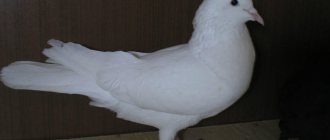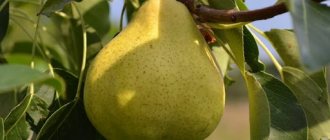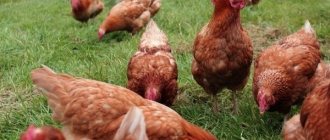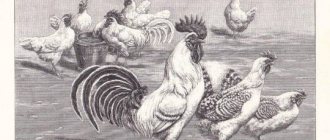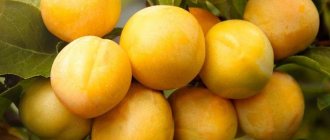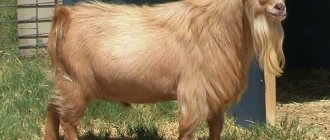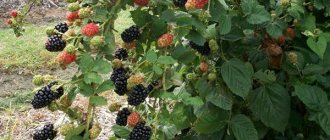148
no comments yet
0
Breed: monk
Main breed group: decorative, flight racing
Subgroup: German, Moscow, Ural, Tula, Altai
Main colors: black, blue, silver, red, yellow, ash, white, coffee
Pigeon weight (kg): 1
Dove weight (kg): 0.8
Pigeon marking ring size (mm, Ø): 8
Dove marking ring size (mm, Ø): 7
Flight characteristics: short, low, circular (German monks). Tall and long (other varieties)
Ability to incubate and feed chicks: good
Fertility: good
Viability: good
Distribution: small
The Monk pigeon breed has several varieties:
- German monks were bred in Germany by breeders in the 17th century as rutting dogs for hunters.
- Tula monks were brought out in the middle of the 19th century in the city of the same name, and then they spread to other cities of Russia.
- The Moscow branch was created by crossing Warsaw long-billed tumblers with Hamburg calots. The best qualities of the breed were secured by breeder V.I. Surovezhin.
- exact information about the origin of the Ural monks . It is believed that they were bred by crossing Ural forelock breeds with Tula monks and calots.
- Altai monk (Barnaul lop-eared) was obtained through selection of the Ural monk.
Today, the monk breed is bred as an ornamental and flying breed.
Altai variety
Barnaul lop-winged monk (big-headed) is a breed of ornamental birds obtained in Altai. They were bred from the Ural monks, who are characterized by an abundance of decorations: a cap and crest on the head, shaggy hair on the legs. However, Altai breeders developed a new breed, the birds became more graceful. The color of the head feathers can be red, black, brown or yellow.
Altai monks are beautiful ornamental birds bred in the Urals.
Pigeon monks are distinguished by great cleanliness and goodwill towards people. They are unpretentious in nutrition and do not require special conditions. These birds become strongly attached to their owners and home. Monk pigeons are good parents; they provide excellent nutrition and protection to their offspring. Many breeders specifically keep them to feed other people's chicks of more valuable species, including chicks of short-beaked breeds. With proper maintenance, a pair of pigeons produces three or four broods over the summer, but in unfavorable conditions the birds produce at most two broods.
Breeders keeping short-billed birds, such as tumblers, are advised to use monks as feeders for other people's offspring.
The main thing for proper breeding of monks is the presence of a specially equipped poultry house and balanced feed.
Video
Features of Moscow pigeons
The plumage of Moscow monks includes all shades from black or brown to blue and yellow. Birds are not able to fly for a long time, but their flight is characterized by high maneuverability and swiftness. According to one version, pigeons were called monks because of their appearance; according to another, these birds tend to fight off the flock and fly alone.
Moscow monk pigeons do not fly very high, but they are fast and maneuverable.
Characteristics of the species
Monks are an interesting breed. Pigeons are recognizable among other representatives of the bird family due to a peculiar crest or crest located in the back of the head. These stylish and harmoniously built birds can have a variety of colors, which range from white and brown to blue, coffee, silver and red.
Immediately after the appearance of this species, birds were called exclusively German, but when they became popular in Russia and Ukraine, they acquired the name crusades. The monks still have an internal division into types - Moscow and German. Although they belong to the same type of bird and are similar in appearance, experts classify them as different.
When keeping such pets, the main thing is balanced food, suitable for other species, as well as rearing in an equipped poultry house, which is built based on the number of birds.
Appearance of pigeons
A distinctive feature of the species is the rich and even color of the plumage. Their body is most often colored classic white, and the feathers of the first order and located in the tail are usually of a different shade. Areas other than the head and tail may be black, brown, yellow or blue. The eyes are characterized by a white or pearl color. The birds naturally had a long and rather flat tail, a medium-sized beak, red limbs with light claws. They always have a dark cap on their head.
Origin
In the 17th century, a breed of bird was developed in Germany, initially called the German monk. Later, they began to be called differently, thanks to the noticeable cross on the wings, which is visualized when the pigeons open them in flight.
The success of German breeders was enormous - later this species of bird received a standard. In the ethnic homeland of handsome dogs, it is customary to organize special exhibitions where each breeder can present their pets and receive praise from the public.
The ancestors of these beautiful birds lived in Germany, from where they came to Poland, and then to our country.
Behavior
Such pets are not characterized by high flight. They flock together and are close to each other.
The jumping birds especially stand out. They received this nickname because when they see a stranger, they quickly rush towards him and encourage him to spend time with their fellow tribesmen.
Birds can spend many hours sitting on the roof. These birds are not demanding on living conditions and easily breed in captivity. They are stately, proud and majestic, and at the same time have an affectionate and friendly character.
A little history
Back in the distant 17th century, a breed was bred in Germany that immediately received the name German Monk. There are two versions of origin. According to the first, the reason was the appearance, which is similar to the attire of monks. The second option speaks of the independence of the species and the desire to fly alone. Over time, the name of the breed was supplemented with the word “cross”, because, if you look at the flight from below, the open wings of the Monkhs resemble a cross.
Read also: Common cotoneaster: general information, care features, planting and propagation
It's hard to find pure-blooded Cross Monks these days. The degeneration of the species occurs due to numerous crossings to improve the breed.
Recognition of such birds is possible thanks to their unique appearance.
There are 2 types of Cross Monks: German and Moscow. They are very similar to each other, but have different feather colors: from brown and silver to reddish and blue.
What are the signs that indicate a lack of purity in a breed?
Many people often simply admire decorative beauties in life and in photos, not paying attention to small details. The German Monk is a pigeon that has minor flaws indicating a mixed breed:
- dark claws;
- short wings;
- sunken chest;
- shorter than 15 mm beak;
- short legs;
- too wide tail with several light feathers.
But this list of defects is not as critical as the following: a light tail, the absence of a crest or its insufficient thickness, feathers on the legs, a small body, white stripes on the head, a large beak, an oversized head, a reddish or yellow iris, snow-white stripes on the head. Such birds are not allowed to participate in exhibitions.
All owners of representatives of this endangered breed are guaranteed the joy of admiring them. As they say, who can forbid “blueness” next to such handsome men on the farm?
Characteristics of Monk pigeons
Among the variety of species of pigeons long tamed by people, the ancient Monk breed stands out. These birds are popular among hobbyists and those who breed birds professionally. The peculiar appearance and refined behavior of these winged birds are noticeable not only in life, but also in photographs. So, Monk pigeons - what are they?
Loyal birds with a special parental instinct
Breeding Moscow monk pigeons is not difficult. Birds of this breed are easy to care for and easily adapt to the conditions of captivity.
The main expenses go towards equipping the dovecote, the size of which depends on the number of birds. There should be no bars inside such a nursery so that the birds have complete freedom of movement.
Signs of a well-equipped bird nursery are sufficient natural light, plenty of air, cleanliness, and safety. Each pigeon should have its own place to rest, lay eggs and hatch offspring.
Dove perches can be made from aspen, elderberry or poplar - wooden perches are easier to clean. Correctly made devices for housing birds help to carry out high-quality disease prevention and disinfection in the dovecote.
Monks are clean and very friendly birds; these pigeons become attached to people, become tame and devoted.
Some pigeon breeders breed monks because of their special parental responsibilities. These birds can hatch and take excellent care of other people's chicks of more expensive breeds. Their “services” are often used when breeding short-beaked species of pigeons.
Content Features
Birds of this breed are unpretentious in care and easily adapt to captivity.
It is important that the pigeons have enough light, air, and that it is clean and safe.
Important! Monks are clean birds that become strongly attached to their owner and are distinguished by great devotion. In addition, they have increased parental responsibility; they easily even take care of other people’s chicks of other breeds.
Indoor conditions
There should not be any bars inside the dovecote; the birds should have complete freedom of movement. Since pigeons are clean, they need systematic cleaning of the dovecote and its disinfection.
Find out how to build a dovecote with your own hands.
During cleaning, you need to thoroughly clean resting areas, as well as drinking bowls and feeders from food debris. Disinfection is usually carried out once a month. At this time, the birds are removed from the dovecote and all surfaces are thoroughly treated with a disinfectant solution, after which the room needs to be well ventilated.
What to feed
Cross monks are omnivores. It is important that their diet is balanced, only in this case the pigeons will not get sick and remain hardy.
The diet of birds of this breed consists of the following food:
- Oats and barley. Contains a lot of fiber, which has a positive effect on the functioning of the stomach.
- Corn. It is easily absorbed by the body, and at the same time surpasses other feeds in energy value.
- Lentils. Source of plant proteins.
- Hemp and flaxseed. Replenishes the level of amino acids and fats in the body.
- Millet. Contains a large amount of vitamins necessary for birds.
Read more about what to feed pigeons and pigeons, as well as what vitamins are best to give to pigeons.
It would be useful to add fish oil at the rate of 10 ml per 1 kg of feed. After goiter milk, babies are initially given wheat soaked in water.
Video: how to feed and water pigeons
Despite the fact that it is difficult to meet purebred monks today, however, if you set a goal to breed these beauties, you can find a couple that, with proper care, will be able to produce offspring, and they will later become a whole flock.
Did you know? Each pigeon is attached to its territory, even if the bird is taken to another place, it will return home. Scientists believe that these birds react to the earth's magnetic field.
Peculiarities
Although there are fighters among the monks, in general they are a peaceful and affectionate breed. Moreover, its representatives are happy to “get to know” strangers and are never averse to inviting them into their flock. This is exactly what they do: they jump to strangers and invite them to come to them.
By the way, German and Moscow cross monks have excellent parental instincts. Some pigeon breeders keep them so that they hatch and then nurse other people's chicks. But they also have a lot of their own young. So, with proper care, they bring three or even four broods per year.
Content
Cross monks are an omnivorous species. Their food should be balanced and it is no different from food for other pigeons.
They are resistant to various diseases and hardy. The costs of caring for them are insignificant and consist mainly of equipping the dovecote. In addition, these pigeons are clean and very loyal to their home and owners.
Read also: What is useful, how to use and how to prepare golden mustache tincture with vodka
Cute white crest and proportional body size
Today, purebred cross monks are practically never found, due to indiscriminate interbreeding. Initially, this species of bird was called “Standard”. Among other breeds of monks, there is a peculiar crest (usually white and wide spread on the back of the head), and an unusual color.
The colors of pigeons are interesting: the body plumage is mainly white, but the head, throat, mandible, tail and first flight wings are colored. The breed of these birds also has the following color options: brown, silver, coffee, black, gray, yellow, reddish.
The body of an adult monk pigeon is of medium size, slightly inclined and slightly elongated. The addition is harmonious, proportional. The average body length of the bird is 35-36 cm. Long, strong wings when folded fit tightly to the sides, the tail is elongated and flat. The legs of the monk breed without feathers are red, and the nails are white.
a brief description of
The monk has the following characteristics:
- The main feature is considered to be a crest on the back of the head made of thick white feathers;
- strong body 35 cm long;
- elongated shape, body slightly tilted forward;
- legs without feathers;
- small eyes with moving black pupils;
- forehead, which turns into a delicate small beak 15 mm long;
- graceful neck, smoothly turning into the body;
- a spectacular comb, which is considered to be a sign of the purebred of the breed;
- developed wide chest;
- long wings pressed to the body;
- medium-sized tail with 12 tail feathers;
- a light-colored body, which is decorated with a tail of a different color, a cap on the head, which can be yellow, black and coffee;
- They can fly at low altitude and for a short time.
Monk pigeons differ from other pigeons by the contrast of their white body with a dark head and tail. The bird is extremely friendly and when it sees other pigeons flying past, it hurries to meet them and invites them to join the flock. In any photo you can see the proud posture and graceful flight of birds. In addition, the Monk is incredibly resistant to external influences and hardy.
Care
The main condition affecting the quality of pigeon breeding in winter is the temperature in the dovecote, which even in winter should not be below 10°C. Otherwise, the likelihood that the offspring may freeze increases
It is worth paying attention to the lighting of the dovecote; for these birds it is important that daylight lasts at least 12 hours, which is impossible in winter without additional lighting.
The daily diet of pigeons should contain a number of vitamins, fats, carbohydrates and proteins. Each element is indispensable in the daily diet of pigeons. Don’t forget about birds’ free access to clean water. Water is the main participant in the digestion process.
Carbohydrates give the bird additional energy, which is simply necessary for its active movement. Proteins are indispensable for the growth and proper development of internal organs; they are also involved in the formation of eggs in females and the quality of plumage. Fats help the bird cope with diseases, and in case of starvation, live for some time using its reserves.
Cross monks are very popular among breeders in Russia and neighboring countries. First of all, for his very friendly and sociable disposition, obedience and accuracy. These birds are very attached to their home, moreover, they are beautiful and unpretentious. They are considered one of the most affectionate birds among pigeons.
Source: Rex24.ru
Possible problems
In general, cross monks are considered one of the calmest and most affectionate among other breeds of pigeons. They are very beautiful in appearance, undemanding to food and very friendly. Difficulties in breeding pigeons can probably be caused by indifference and failure to comply with basic conditions for caring for them. Properly equipped dovecotes and balanced nutrition will provide the monks of the cross with the most comfortable living conditions. Easy adaptation to keeping in dovecotes, unpretentiousness in care allows you to breed cross monks without much difficulty. The main thing is to provide them with proper comfortable living conditions, and then they will be able to delight their owners with their beauty for a long time.
To see what monk breed pigeons look like, see the following video.
stroy-podskazka.ru
Temperamental birds with pearly eyes
Monk pigeons that do not have racial characteristics are not allowed to be bred. To preserve purebred characteristics, birds are selected according to external criteria:
- the head should be round, slightly elongated, with a sloping forehead;
- crown and occipital region rounded;
- The pigeon's neck is short and dense;
- light pearl eyes of medium size with a centrally located pupil;
- eyelids are narrow, dark gray, flesh-colored or light red;
- beak 1.5-1.7 cm long, tightly closed, noble with a neat white wax;
- shields and belts are missing.
Monks are temperamental, strong birds, good fliers - they can slip through the canopy of trees.
During daily training, representatives of the breed of monk pigeons stay in flight for 2-3 hours - they do not rise to great heights, but move quickly and maneuverably.
The birds look majestic and stately. Pigeons in a flock flock together, which looks very beautiful in the sky.
Intraspecific varieties of Altai beauties
Monks are divided into Moscow and German pigeons. They are similar in appearance, but breeders classify them as separate subspecies. Ornithologists note a clearer coloration among the “Germans”. The snow-white feathers of the bird's body are replaced by brown ones at the tip of the tail and the “cap”.
The Moscow cross pigeon is very similar to its brother. Its plumage is also white, and the areas on the top of its head and tail can be brown and black.
The Barnaul monk is of particular decorative interest. It is also known as the lop-winged or big-headed pigeon. This type was bred in Altai at the beginning of the 20th century. Birds of this breed are original and unusual. They are distinguished by an abundance of decorations: the color of the feathers on the head can be yellow, brown, red, and the legs are covered with beautiful shaggy hair.
When breeding this breed of pigeons, it is important to keep the dovecote clean and dry. Since the legs and feet are covered with feathers, birds can get them wet and dirty.
In the nursery, you can scatter lime, wood shavings, or use specialized bedding.
How to distinguish an outbred
Despite the fact that ordinary people do not pay attention to small details in the appearance of certain birds, avid breeders know exactly how to distinguish a purebred representative by seeing all the flaws at once.
Let's look at what shortcomings monks have that are considered minor:
- dark marigolds;
- the tail has feathers of a light shade;
- wings of short length;
- beak shorter than 15 mm;
- sunken chest.
Check out the different types of high-flying, wood and wild pigeons, as well as the strangest and...
The following characteristics are considered to be completely incompatible with a purebred breed:
- absence of a crest or its sparse plumage;
- light-colored tail;
- small body;
- the presence of feathers on the legs;
- plumage color without clear boundaries;
- the presence of white stripes on the head;
- large head;
- thick beak.
Birds that have at least some of the characteristics outlined above cannot take part in exhibitions as representatives of the Cross Monk breed.
Moscow monks
Main section: Racing pigeons
Additions to the main section:
- > Moscow monks
- Arkhangelsk bullfinches
- Coppery blackwings
- Coppery with blue wings
- Coppery with blue-black wings
- Golden with black and blue wings
- Golden white
- Ural monks
- Kyiv light (fireflies)
- Crimean forelocks
- Nizhyn pigeons
- Krylov white pigeons
- Kaunas moths
- Riga Turmans
- Riga mirror
- Cross monks
- Budapest mirrors
- Elbing white-headed
Hide advertisements in article
These pigeons have a characteristic plumage pattern. With snow-white plumage throughout the body, a colored cap is “put on” the head and the tail is painted the same color. Pigeons got their name “monks” from the black cap on their heads. The breed was bred at the beginning of the 20th century by pigeon breeders in Moscow and the Moscow region. The birds were obtained by crossing the Hamburg calot with the Warsaw long-headed tumbler. A mass-breeding bird, it is especially popular among lovers of Moscow and the Moscow region. For almost a hundred years, the breed has been constantly transforming. In the 30s, the famous breeder V.I. Surovezhin made a great contribution to the creation of the monk breed. At the end of the 50s, the size of the bird increases, the head becomes more massive, rounded and elongated, with a gently sloping elongated forehead, a rounded nape, decorated with a shell-shaped high forelock. In the early 60s, several leading pigeon breeders in Moscow, headed by V. Voronin, began to work seriously with the breed. He purchased several copies of the fawn color from the once famous lover of monks V. Lukyanov and began to work with this bird. As a result of closely related mating, he managed to achieve certain successes. The flight qualities of the breed have improved. However, along with many positive aspects, the bird began to shrink. I had to add the blood of coffee (brown) monks to the fawn monks.
In recent years, the championship in breed selection has passed to V. Kharlashin. At the International Anniversary Exhibition of Pigeons in Moscow in 1997, V. Voronin, V. Kretinin and V. Kharlashin exhibited elite Moscow monks. The champion of the exhibition was a pigeon from the farm of V. Kharlashin.
The monks' flight is circular, at low altitude, in a flock, and short-lived. Pigeons are unpretentious, viable, active, sometimes pugnacious, fertile, and feed their chicks well.
The breed standard was developed and approved in the early 70s by the Moscow Club of Pigeon Breeders.
Birds of medium size (total length 34–36 cm), strong build, with an elongated, slightly inclined body, smooth plumage that fits well to the body. The head is rounded-elongated, narrow, dry, with a gently sloping elongated forehead, a rounded nape, decorated with shell-shaped, dense, high, turning into a mane at the back, and on the sides a forelock with curls at the ends descending to the ears. The eyes are medium-sized, lively, expressive, with a white or pearl iris and a dark pupil; eyelids are narrow, flesh-colored. The beak is of medium length (1517 mm), not rough, rather thin, straight, well closed, in black pigeons it is white, in fawn and coffee pigeons it is forest-colored, the wax is white, oblong, tightly adjacent to the beak. The neck is of medium length, relatively thin at the head, then smoothly blending into the chest and back; on the back of the neck the mane is a continuation of the forelock. The chest is relatively wide, rounded, slightly raised. The back is straight, elongated, sloping towards the tail. The wings are long, closed, tightly fitting to the body, lie on the tail, but do not cross at the ends. The tail is flat, long, narrow, consisting of 12 feathers with a smooth transition to the back. The legs are of medium length, unfeathered, light red, the claws are light. The plumage of the entire body is pure white, with the exception of the upper part of the head up to the eye line, forelock and tail, which can be black, coffee or fawn. The color should be rich and even.
Other articles from the section “Breeds of Domestic Pigeons”:
·
Exterior features and constitution
·
Classification of pigeon breeds
·
Pure pigeons
·
Modern breeds
·
Short-billed tumblers
·
Long-billed tumblers
·
Stately pigeons
·
Color-breasted subgroup
·
sided subgroup
·
subgroup · Solid-colored subgroup
·
Motley subgroup
>
Racing pigeons
·
High-flying pigeons
·
Fighting pigeons (bii)
·
Trumpeters and drummers
·
Sports (homing) pigeons
·
Decorative pigeons
·
Seagulls
·
Meat pigeons
<< Back |
| Racing pigeons Arkhangelsk bullfinches
General characteristics
Latin name: Columba livia domestica
The English cross pigeon (Nun pigeon) is an ornamental breed bred in Great Britain. Pigeons of this breed are white in color. The head is crowned with a hood of feathers, which gives the breed its name.
Immediately after breeding, the breed was called German, but then, after prolonged breeding in Russia and Ukraine, the name “cross” was attached to the pigeons. When flying, pigeons of this species open their wings so that a cross on them becomes noticeable. Currently, birds of this species are bred in Russia, Ukraine, Kazakhstan, Tatarstan, and, of course, in Germany itself.
Initially, the breed was bred as a rutting breed - it was supposed to take part in the hunt, scaring off those birds that were hiding in the crowns of trees, piercing right through the foliage and branches. Therefore, “monks” definitely need periodic training. Some of the representatives of the breed do not like to fly with the flock, which has earned them another nickname - hermits.
History of the breed
The ancient German species of cross pigeons was bred in Germany in the mid-17th century. The original purpose of these birds was to participate in hunting, to scare away birds hiding in the dense foliage of trees. Pigeons were also raised on poultry farms for their tender meat.
Later, monk pigeons acquired a more decorative purpose and began to be raised by bird lovers for spiritual pleasure.
The birds acquired their name “cross monk” due to the cross that appears on the wings , which is detected during flight, as well as the unusual coloring of the feathers, similar to monastic clothes. According to another option, the name of the breed comes from a behavior similar to hermit monks, when some pigeons fly separately from their flock.
Description of the breed
Individuals of this species are very beautiful. These are harmonious, strong birds with a recognizable “crest” or “crest” on the back of the head. The color of representatives of monk pigeons can be very diverse - from white and brown to blue, coffee, brown, silver and even red. Immediately after breeding, the breed was called German, but then, after prolonged breeding in Russia and Ukraine, the name “cross” was attached to the pigeons.
A distinctive feature is a clear, rich and even color. Their body is predominantly white, but the tail and first-order feathers in the wings are always colored in some shade. Birds' eyes are pearly or white. The tail is long, flat, the beak is small, the legs are red with light-colored claws. A beautiful representative of the breed can be seen in the photo provided above.
Cross monks are very popular among breeders in Russia and neighboring countries. First of all, for his very friendly and sociable disposition, obedience and accuracy. Cross monks are very attached to their home, and are also beautiful and unpretentious. Another photo illustrates how harmoniously these birds are built.
Origin
German pigeon breeders in the 17th century developed a breed that was first called the “German monk”, but then was renamed the cross. The success of breeders from Germany was colossal - they bred a breed that was later assigned a standard. Why did the name change? When flying, pigeons of this species open their wings so that a cross on them becomes noticeable. Currently, birds of this species are bred in the Russian Federation, Ukraine, Kazakhstan, Tatarstan, and, of course, in Germany itself.
Specialized exhibitions are even held in the ethnic homeland, where breeders can boast of beautiful birds. The following photo of the cross monk illustrates the beauty and neatness of the bird!
Peculiarities
Monks usually circle not too high, form a flock, and stay close to each other. The jumping pigeons are especially notable. They can sit on the roof for hours, but as soon as they notice someone else's pigeon, they immediately take off. Then, flying up to the stranger, they seem to call him to join the company in their dovecote.
The name “monk” was attached to them because of the characteristic cap on the back of the head. These friendly creatures are one of the most affectionate birds among pigeons.
Specifics of subspecies
Now let's find out how the German Monk and the Moscow Monk differ. Both of them have a crest. But Moscow Monks were developed quite recently: in the twentieth century. They are snow-white, like all Cross Monks, but differ in the color of the feathers on the crest: while the German subspecies is recognizable by its brown plumage, the Moscow subspecies can have a black to reddish-yellow hue. In addition, birds with a brown “cap” and a coffee-colored tail have a flesh-colored beak, while those with a black one have a white beak. The Altai Monk is distinguished by its grace and the fact that the crest can be of any color.
Individual characteristics do not allow pets to make long flights and rise too high from the ground. Winged birds skillfully create a flock and stay quite close to each other in it. Jumping pigeons stand out from the general background. Such individuals sit on the roof for half a day, but when they see strangers they rush towards them, as if calling to join them. Bird breeders deservedly consider them the calmest and most affectionate among their kind.
Cross Monks are clean and friendly, they become attached to people and are unpretentious in their living conditions. Caring for them will not take much effort and time. They are very good parents and take good care of their offspring. Breeders take advantage of their parental qualities and use them to feed chicks of other breeds, even more valuable ones. Proper care will ensure 3 or even 4 broods in one summer.
The Cross Monk must be kept in a special poultry house and constantly provided with high-quality, balanced feed. Individuals are omnivorous and resistant to various diseases. When planning to acquire representatives of this rare breed, it is important to know that there will be no hassle or special expenses.
Pigeons Monks Cross features, description and photo of the breed
Pigeons Monks (Cross) are divided into German and Moscow crusades. They belong to the same species and are slightly different in appearance, but they are separated by a number of characteristics.
German and Moscow monk pigeons belong to the same species, but differ from each other in several important characteristics.
Description
German crusade monks were bred in the 17th century in Germany. Initially they were called German monks. Later, the birds were renamed crosses due to the peculiarity of their coloring: in flight, a dove with spread wings resembles a cross.
Standard appearance of a purebred individual:
- General features: proportional strong build, body length about 35 cm, body inclined, slightly elongated, plumage color has a typical pattern, feathers are well adjacent to the body, legs are devoid of feathering.
- The head is round, slightly elongated, the forehead is sloping, the occipital region and crown are rounded.
- The crest is located between the ears; it should be well defined and consist of thick, densely spaced feathers. On both sides there are rosettes of smaller feathers.
- Eyes of medium size.
- The pupil is located in the middle of the eye: small, black, alive. The iris should be light, the eyelids should be narrow and flesh-colored.
- The beak is small, neat, and has noble contours. Its length is 15-16 mm. The smooth and thin beak continues the line of the forehead. The cere adheres well to it.
- The neck is of medium length and volume. Near the head it is quite thin, but in the shoulder area it becomes thicker and smoothly flows into the back and chest. A pronounced comb is considered a sign of high breeding, and connoisseurs value it.
- The chest is wide - 24-25 cm in girth.
- The back is elongated, the transition to the tail is weakly expressed.
- The wings are pressed tightly to the body and are quite long. Their ends do not fall below the tail.
- The tail is of medium length, it includes 12 tail feathers, and is relatively flat.
- The legs are reddish, with light claws, without feathers.
- The body of the bird is light. The color of the tail and cap varies between yellow, black, and coffee colors. The pattern extends along the cheeks to the crest, which in a purebred individual should remain snow-white.
- The flight is short and low.
The main difference between the monk pigeon is its light body combined with a darker head and tail.
Pigeons with gross deviations from the standard appearance should not be allowed into breeding.
These are extremely friendly creatures - when they see a strange pigeon, the males, who are called “jumpers,” fly out to meet him and invite him to join the flock.
It has already been said that German monk pigeons, like Moscow ones, have a crest on their heads.
Features of Moscow pigeons
The plumage of Moscow monks includes all shades from black or brown to blue and yellow. Birds are not able to fly for a long time, but their flight is characterized by high maneuverability and swiftness. According to one version, pigeons were called monks because of their appearance; according to another, these birds tend to fight off the flock and fly alone.
Moscow monk pigeons do not fly very high, but they are fast and maneuverable.
Altai variety
Barnaul lop-winged monk (big-headed) is a breed of ornamental birds obtained in Altai. They were bred from the Ural monks, who are characterized by an abundance of decorations: a cap and crest on the head, shaggy hair on the legs. However, Altai breeders developed a new breed, the birds became more graceful. The color of the head feathers can be red, black, brown or yellow.
Altai monks are beautiful ornamental birds bred in the Urals.
Pigeon monks are distinguished by great cleanliness and goodwill towards people. They are unpretentious in nutrition and do not require special conditions. These birds become strongly attached to their owners and home.
Monk pigeons are good parents; they provide excellent nutrition and protection to their offspring. Many breeders specifically keep them to feed other people's chicks of more valuable species, including chicks of short-beaked breeds.
With proper maintenance, a pair of pigeons produces three or four broods over the summer, but in unfavorable conditions the birds produce at most two broods.
Breeders keeping short-billed birds, such as tumblers, are advised to use monks as feeders for other people's offspring.
https://www.youtube.com/watch?v=UF9o4w-LSRc
The main thing for proper breeding of monks is the presence of a specially equipped poultry house and balanced feed.
Attention, TODAY only! Subscribe Stay up to date with new products on our site
Breed characteristics
Monks are an interesting breed, which is divided into varieties: Moscow and German. Apart from the color of the feathers, there is no difference between them.
In the first, the main color is white, only the top of the head and tail are painted a different color; in the German, the body is also white, but unlike the previous ones, the ends of the wings and tail are painted in a different color. However, experts consider them to be separate subspecies. Let's consider what distinctive features this breed of pigeons is endowed with.
Appearance
The standard appearance of a purebred individual has the following characteristics:
- The plumage is light. The color of the tail and cap can be yellow, coffee or even black. The crest of purebred representatives should be white.
- The body is large, its length is approximately 35 cm, while it is slightly elongated and inclined forward.
- The head is round, the forehead is sloping. Between the ears there is a tuft of tightly packed feathers.
- The neck is of medium length. Near the head it is thinner than in the shoulder area.
- The chest is quite wide, approximately 24 cm in circumference.
- The back is elongated, the transition to the tail is practically absent.
- Eyes are medium size. The pupil is black, the eyelids are flesh-colored.
- The beak is smooth, small in size, its length is no more than 16 mm.
- The wings are pressed to the body and are quite long, but the ends do not fall below the tail.
- The tail consists of 12 tail feathers and is flat in shape.
- Legs – without feathers, red, with light claws.
Pigeons that have visible deviations from the standard appearance are not purebred monks.
Cross monks do not like to fly high and for a long time; they prefer to sit on roofs, while being quite close to each other. Despite the fact that these birds are proud and majestic, they are endowed with an affectionate and friendly character.
Read also: How to preserve arugula for the winter: dry or freeze? What are the benefits of arugula?
Breeders have noticed that pigeons like to invite newcomers into their flock. To do this, they fly up to them and jump around - as a result of such actions, the newcomer joins them and becomes a member of the flock.
Description
It is customary to distinguish between German crusade monks and Moscow monks. This is one species that has significant similarities, but experts usually divide them into subspecies. Due to long-term selection, the color of their plumage varies from brown to silver, blue and reddish shades.
German monk
The color of the “Germans” is clear: white feathers on the body, and brown on the tail and along the edge of the wings. The eyes are white, fading to pearly with a black pupil and a light iris around. The strong body is inclined forward, about 35 cm long, the chest is also strong, with a circumference of about 25 cm. The wings are long and fit tightly to the sides.
A long, flat tail, faintly prominent at the junction with the body. It has up to 12 feathers, which are the tail feathers. A small beak with a clear outline, only 15 mm long. Paws without feathers, red with white claws.
Their head is elongated, round in shape, with a sloping forehead and a rounded crown. A mandatory feature of the breed is the crest, which has finely curled feathers on both sides. The neck is wide at the base, and becomes noticeably thinner closer to the head.
Moscow monk
It is widely believed that Moscow monks appeared only at the beginning of the twentieth century in Moscow. They were obtained after crossing the Warsaw Silver breed and the German Calot.
These decorative pigeons are very similar to their German predecessors: they have a snow-white “robe”, on which only part of the head and tail is decorated with feathers of brown and black shades (less often with blue or even yellow). The color changes near the beak, at the base of the forehead, goes to the cheeks (under the eyes) and becomes a rounded line near the base of the crest.
The crest in the form of disheveled feathers is located on the back of the head and is very well defined. It is its noticeable dishevelment (against the background of smooth plumage) and white color that are considered a sign of high breeding of all monks.
Pigeons with a black color have a white beak, and those with a “hat” and tail of coffee shades have a flesh-colored beak.
Representatives of the breed are not adapted for long flights, and they fly at low altitudes, but maneuverably.
Varieties
There are two main varieties of this breed - German Cross pigeons and Moscow Monks.
Each of these varieties is different in its own way, and now we will look at their main features. German Monks, as ornithologists testify, have a clearer color. Their feathers are snow-white, and the tip of the tail and the characteristic “cap” on the head are colored brown. The eyes are also white, have a small black pupil and a light iris. Their body is located slightly at an angle, about 35 cm long, their chest is quite wide - 24–25 cm, but their tail is flat, long, and stands out very faintly at the junction with the body.
The beak is small and sharp, and the head is round and slightly elongated. There is also a snow-white crest sticking up, which distinguishes them from other breeds of pigeons. Moscow pigeons are very similar to their German counterparts. They appeared only in the twentieth century on the territory of Warsaw. Their plumage is also white, and on the top of the head and the very tip of the tail there are areas that are colored brown or even black.
The color of the beak may change slightly; similar changes can also be observed in the forehead area (at its base) and under the eyes. Their crest is very disheveled, snow-white, and is located on the back of the head. The color of the beak may vary depending on the color of the “cap” - if it is black, then it will be white, and if the bird has brown feathers on the top of its head, the beak will be flesh-colored. They also distinguish the Altai variety, which differs from its fellows in that the “cap” can be yellow, red or brown, and the paws are slightly pubescent. These birds were bred exclusively as ornamental birds.
Read also: Features of growing gardenia at home
